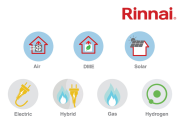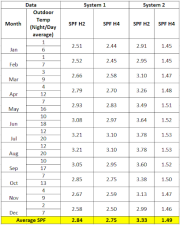Due to the way in which efficiency is measured utilizing a SCOP rating, commercial hot water systems (CHWS) will potentially show a lack of system congruity when considering the entire system, against the expected performance of the heat pump alone, which, as a consequence, affects product expectations and ultimately carbon reductions.
Manufacturers often measure heat pump efficiency using Coefficient of Performance (COP), which is the ratio of useful heat energy produced to the electricity consumed at a specific external air temperature and temperature rise required.
 Due to the way in which efficiency is measured utilizing a SCOP rating, commercial hot water systems (CHWS) will potentially show a lack of system congruity when considering the entire system, against the expected performance of the heat pump alone, which, as a consequence, affects product expectations and ultimately carbon reductions.
Due to the way in which efficiency is measured utilizing a SCOP rating, commercial hot water systems (CHWS) will potentially show a lack of system congruity when considering the entire system, against the expected performance of the heat pump alone, which, as a consequence, affects product expectations and ultimately carbon reductions.
Instead, the Rinnai White paper has adopted the ‘Seasonal Performance Factor’ which evaluates all energy utilizing components within a commercial hot water system, therefore, measuring the performance of the entire system as opposed to solely the heat pump.
This Rinnai White Paper on SPF, authored by Sean Ehlen M Eng, also presents a detailed case study to underline the two systems of thought used within the hot water dispersal industry. These are used to inform potential customers of a system’s efficiency.
 By presenting this White Paper to UK customers, Rinnai aims to provide information that delivers a concise and true account of commercial hot water performance using the ‘Seasonal Performance Factor’ methodology.
By presenting this White Paper to UK customers, Rinnai aims to provide information that delivers a concise and true account of commercial hot water performance using the ‘Seasonal Performance Factor’ methodology.
The case study presents two heat pump systems:
- System 1 covers the DHW demand with 100% heat pump;
- System 2 uses 40% heat pump and includes an electric cylinder to provide back-up heat.
The results show that when considering the entire commercial hot water system, including the buildings’ piping system, System 1 has a higher SPF (2.75) than System 2 (1.49), due to System 2 operating the back-up heater in peak times and to recover secondary system heat losses.
However, when observing the SPF of only the heat pump unit, System 2 is higher. This can mislead the customer as they are expecting an SPF of close to 3.33, but the system only performs to an SPF of 1.49, as seen in table 2.
Therefore, the purpose of this White Paper is to highlight the difference in performance between differing system boundaries and works towards informing the customer of the reality of their CHWS.
 Rinnai will continue to inform the UK customer of details that provide an accurate statement of system performance, while considering the effects on operational expenditure, economic investment, and environmental impact. Rinnai understands the significance of an investment during a time of sensitive energy costs. Rinnai aim to share all information that assists the UK customer in decision making that saves money and emissions.
Rinnai will continue to inform the UK customer of details that provide an accurate statement of system performance, while considering the effects on operational expenditure, economic investment, and environmental impact. Rinnai understands the significance of an investment during a time of sensitive energy costs. Rinnai aim to share all information that assists the UK customer in decision making that saves money and emissions.